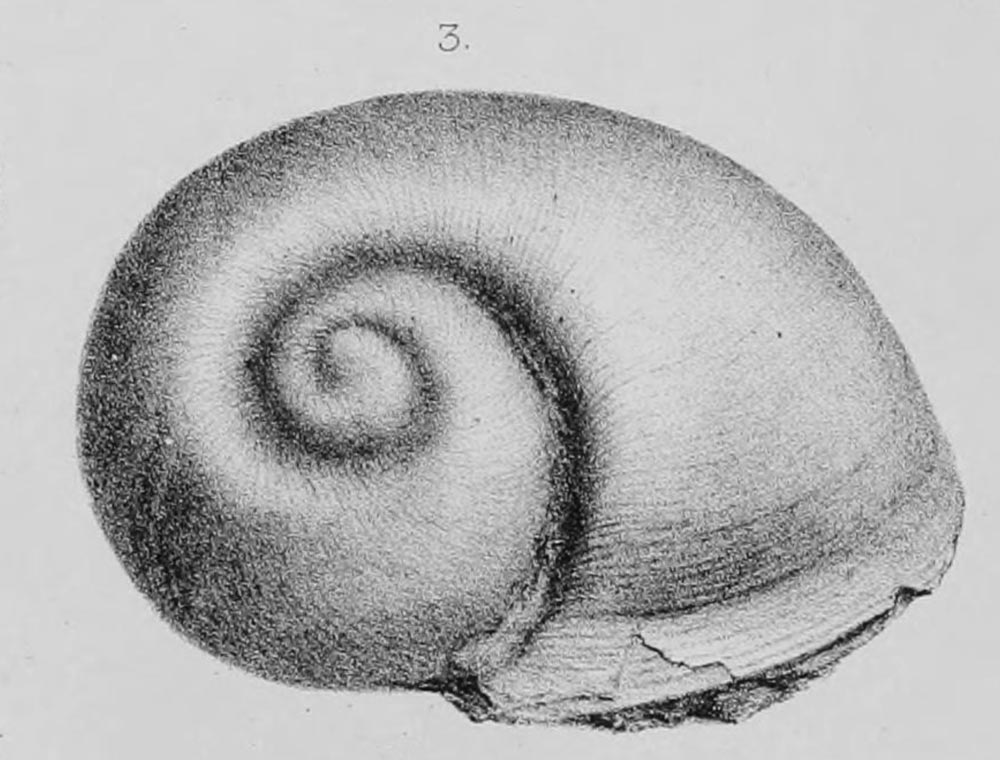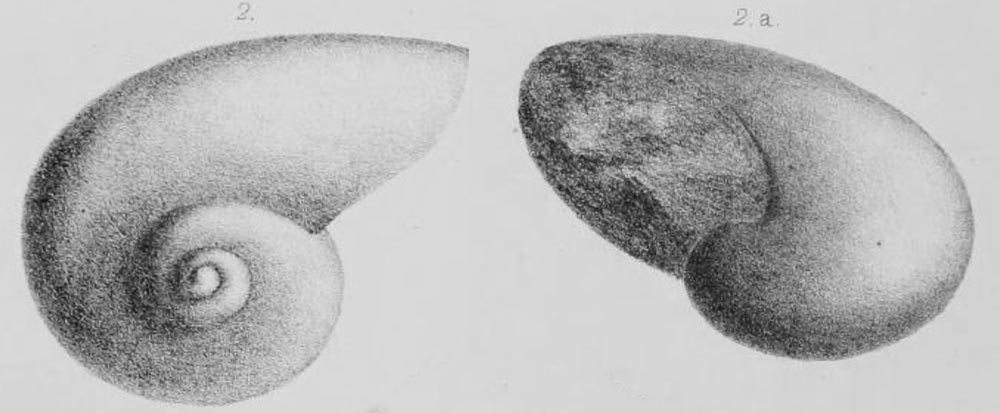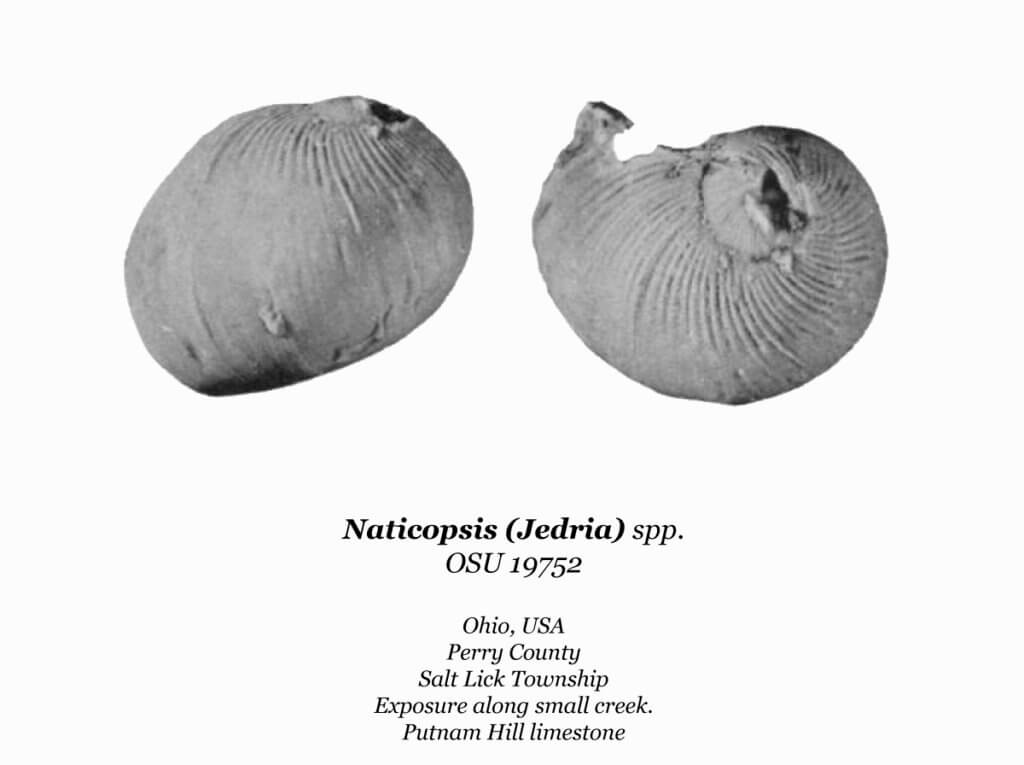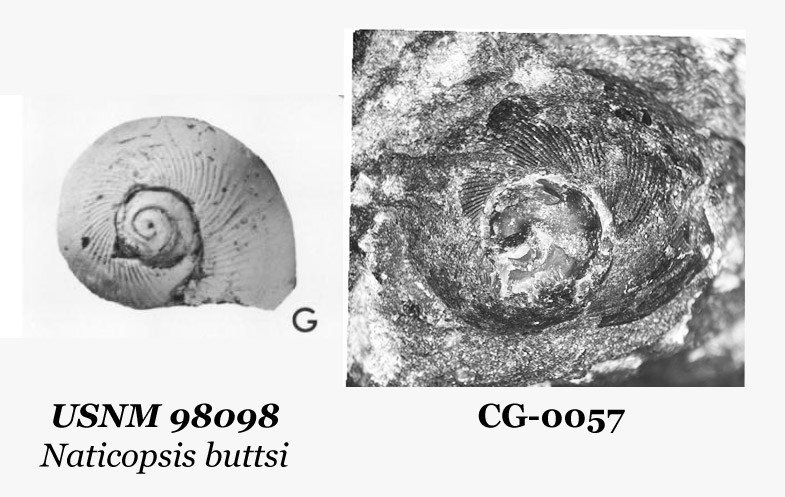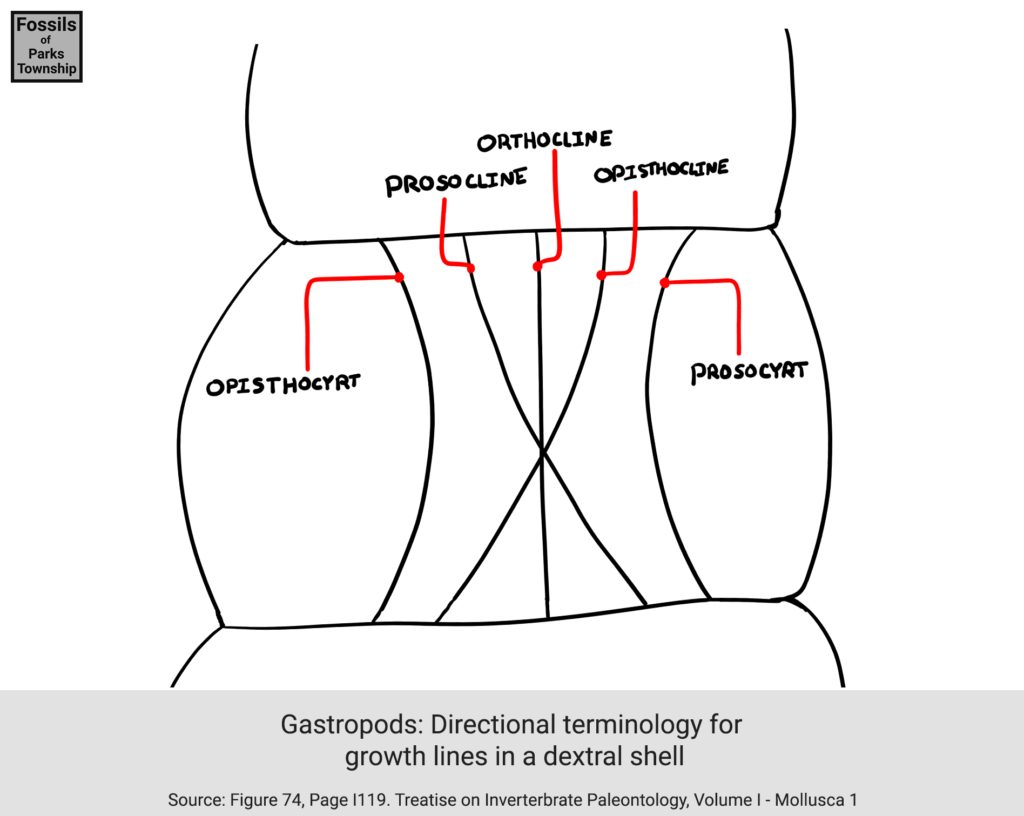Naticopsis is a genus of gastropods that existed for nearly a quarter of a billion years (fossilworks) in the fossil record. It was first described by M’Coy in 1844 using specimens from Ireland. The late Ordovician period has the earliest reported specimens, and the latest is from the Late Triassic. A specimen referenced from the Ordovician period brings skepticism. Only one is reported, and the genus is marked as unsure. This temporal range is unusual with local genera; most of them disappear during the Permian–Triassic mass extinction event.

Interest in Naticopsis for this research stems from specimen CG-0057 in our collection. This gastropod was discovered while splitting a large limestone boulder. Finding specimens varies between breaks, and this was a lucky one. The specimen is a medium-sized shell with a broken-off spire. The subsutural ornament is prosocline and collabral, which can visually be seen in the image below. This is not an ornament style ever found by me locally, thus was set aside. After a short stint considering Mourlonia for identification, Naticopsis was suggested. This necessitated a better understanding of the history of the genus. Also, a search for other collected or figured local specimens was launched.
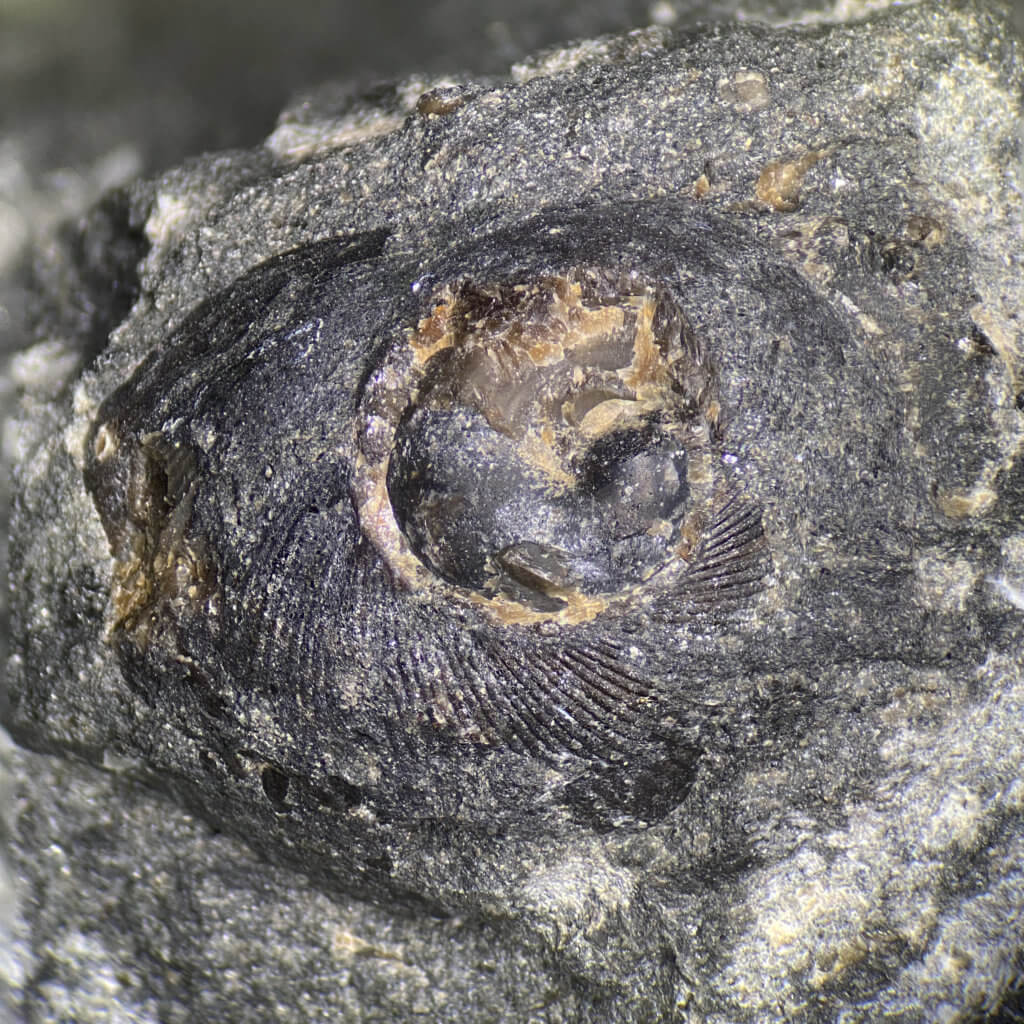
1844: M’Coy creates the genus, Naticopsis
M’Coy created this genus from three other genera, Ampullaria, Natica, and Nerita. M’Coy named seven distinct species of Naticopsis along with his declaration. Four of these were species declared by himself. Two are from Phillips, and one from Sowerby. As characteristics of the genus, he wrote: “Shell globose; inner lip smooth, flattened, slightly thickened; spire very small; umbilicus none.” Three specimens were illustrated in the volume, one on plate V and two on plate VII. The two on plate VII were well within the bounds of the description, but the figure on plate V is lacking and small in size. The measurement is in a unit labeled as lines. The width is 3 lines. According to conversion tables, this is about 1/4 of an inch or .635 cm.
Characteristics of M’Coy’s 7 declared species of Naticopsis
| Species | Author | Characteristics |
|---|---|---|
| N. canaliculata | M’Coy. | Globose; body whorl large; spire depressed of three inflated whorls; sutures deeply channeled; mouth slightly dilated; shell very thin; volutions delicately striated across. |
| N. dubia | M’Coy. | Transversely ovate, very much depressed; spire of three rather convex whorls; mouth transversely ovate; surface smooth; base convex. |
| N. elongata | Phillips | Elongate, very obliquely oval; spire prominent, mammillary, of two Imperfect volutions; surface with very delicate, oblique striae. |
| N. neritoides | M’Coy. | Globose, smooth; length one-fourth less than the width; spire very small, flat, of two whorls; aperture large, semicircular; outer lip thin; Inner lip perfectly straight, thickened, convex. |
| N. phillipsii | M’Coy. | Body whorl large, obliquely oval; spire very small, depressed, of four convex turns; surface perfectly smooth, except at the sutures, which are elegantly marked with sharp, short striae; inner lip very much thickened; convex above, flattened or concave below. |
| N. plicistria | Phillips | Ovate; spire prominent, of three volutions, slightly concave at the sutures, where they are strongly striated; surface with fine, oblique striae. |
| N. sperata | Sowerby | Globose, obliquely compressed; spire flattened, of three turns; volutions sharply striated across; strias rising into a sharp plication at the sutures. |
1953: Ellis L. Yochelson named Jerida as a subgenus
In anticipation of the publication of Part I of the Treatise on Invertebrate Paleontology, Yochelson published a paper about the new subgenus Jerida.
1964: Myron T. Sturgeon reports on Gastropods from Eastern Ohio
Sturgeon put together a comprehensive report on gastropods found in Eastern Ohio. All of these are from the Allegheny Formation, a formation that underlies the Glenshaw Formation. Forty-nine specimens of Naticopsis (Jerida) were reported, with twenty-four of them being of the species N. (Jerida) ventrica. The specimen shown below is a very small specimen but illustrates the subsutural ornamentation well.
Sturgeon noted that large fragments are common in the Vanport Limestone of both Pennsylvania and Ohio. He illustrated a few steinkerns and mentioned that they are likely juvenile specimens.
1982: N. buttsi is named by M. Gordon and E.L. Yochelson
Charles Butts collected a small number of silicified gastropods in 1927. This collection was examined later by Gordon and Yochelson. A specimen was found to have the oldest neritacean operculum recovered in North America. The operculum is a covering for the aperture of a gastropod shell. The creature pulls it shut while under attack from a predator, typically when retracting deeper into the shell. The operculum is attached to the upper portion of the foot. Some species of gastropod lack this part, and some have one that is too small to shut the opening.

The N. buttsi specimen vs our local specimen, CG-0057
One view from the article, particularly with figure G of the holotype (USNM 98098), shows prosocline growth lines visible and is easily comparable across the two specimens. These growth lines are known as collabral cords. Collabral ornament is caused by rising and lowering the growth lines along the mantle edge. This is due to periodic fluctuations in the shell generation process across the entire mantle edge. Spiral ornament is the result of variations of shell secretion along the edge. The genus Shansiella is a great example of a spiral ornament with no noticeable collabral ornament. In most specimens of Naticopsis, the collabral ornament is subsutural. This is the area below the visible shell suture lines or the margins between whorls.
The spire shape is similar, however, the final whorl does appear to be smaller. The final whorl may have more in common with the Naticopsis (Jedria) than Naticopsis (Naticopsis). There are concerns with how far down the ornament goes in CG-0057, but more specimen comparison research is necessary to draw a conclusion.
1997: Hoare, Sturgeon, and Anderson publish a study of gastropods of the Appalachian Basin, including Naticopsis.
There is a vast list of gastropod species that correlates each with finds across the various fossil units in the basin. Eight of these were the gastropod Naticopsis. Four species of Naticopsis can be reasonably found in the Brush Creek limestone. The trio of authors did not illustrate any specimens of Naticopsis, so the data appears to be a summary of several reports over the previous century and a half. All species are possible to find, but four doubtful species are last found no later than in the Vanport or Columbia units in the Allegheny Formation. This leaves four species that are more likely, which are:
| Species | Unit |
|---|---|
| Naticopsis (Jedria) meeki Knight | Found in Putnam Hill & Ames units. |
| N. (J.) ventrica Norwood and Pratten | Found in the Brush Creek – Pine Creek unit |
| N. (Naticopsis) nana Meek and Worthen | Found in the Brush Creek – Pine Creek unit |
| N. (Marmolatella) pulchella Morningstar | Found in Lower Mercer & Ames Units. |
The species N. (Marmolatella) pulchella Morningstar has a long stratigraphic range with no species reported in either the Allegheny Formation or most of the Glenshaw Formation. Naticopsis (Jedria) meeki Knight was reported in the Putnam Hill unit, which is the earliest unit in the Allegheny Formation. While it is entirely possible to find any of these four in local Brush Creek limestone, only two of them were reported in this study.
References
- 1844, F. M’Coy, F. A synopsis of the characters of the Carboniferous limestone fossils of Ireland 1-274
- 1933, Knight, J. B. “The Gastropods of the St. Louis, Missouri, Pennsylvanian Outlier: VI. The Neritidae.” Journal of Paleontology, Vol. 7, no. 4, pp. 359–392. JSTOR, www.jstor.org/stable/1298260.
- 1953, Yochelson, E.L., Jedria, a new subgenus of Naticopis, Journal of the Washington Academy of Sciences, Ver. 43, No. 3, p. 65
- 1964, Sturgeon, M.T., Allegheny Fossil Invertebrates from Eastern Ohio, Gastropoda, Journal of Paleontology, Vol. 38, No. 2, pp. 189-226. JSTOR, www.jstor.org/stable/1301544.
- 1982, Gordon, M., Yochelson, E.L., A Naticopsis Operculum Found in Situ (Gastropoda: Mississippian), Journal of Paleontology, Vol. 56, No. 1, P. 260-265
- 1997, Hoare, R.D., Sturgeon, M.T., Anderson Jr., J.R., Pennsylvanian Marine Gastropods from the Appalachian Basin, Journal of Paleontology, Vol. 71, No. 6 (Nov. 1997), pp. 1019-1039
- 2021, Fossilworks, Genus Page for Naticopsis: http://fossilworks.org/bridge.pl?a=taxonInfo&taxon_no=9005
More Specimens of Naticopsis Online
- LakeNeosho.org – Specimen Page for Jedria meeki (also identified by Yancey)
- ammonit.ru – A black-colored specimen that shows correct ornament
- GB3D Type Fossils – Holotype of Naticopsis elongate (Phillips)
- GB3D Type Fossils – Holotype of Naticopsis globularis

